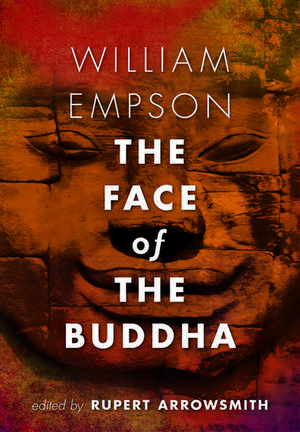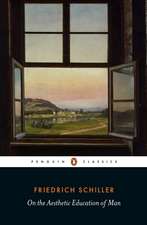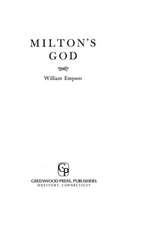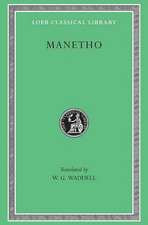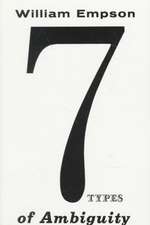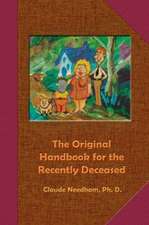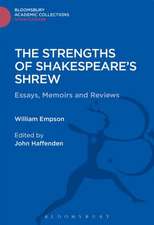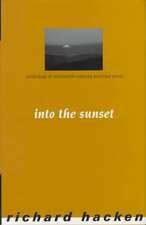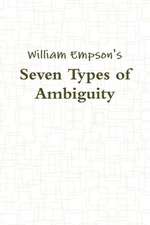The Face of the Buddha
Autor William Empson Editat de Rupert Arrowsmithen Limba Engleză Hardback – 9 iun 2016
Preț: 355.18 lei
Nou
Puncte Express: 533
Preț estimativ în valută:
67.99€ • 73.87$ • 57.14£
67.99€ • 73.87$ • 57.14£
Carte disponibilă
Livrare economică 19-25 martie
Preluare comenzi: 021 569.72.76
Specificații
ISBN-13: 9780199659678
ISBN-10: 0199659672
Pagini: 224
Ilustrații: In-text black-and-white illustrations; 16pp colour plates section
Dimensiuni: 196 x 253 x 19 mm
Greutate: 0.65 kg
Editura: OUP OXFORD
Colecția OUP Oxford
Locul publicării:Oxford, United Kingdom
ISBN-10: 0199659672
Pagini: 224
Ilustrații: In-text black-and-white illustrations; 16pp colour plates section
Dimensiuni: 196 x 253 x 19 mm
Greutate: 0.65 kg
Editura: OUP OXFORD
Colecția OUP Oxford
Locul publicării:Oxford, United Kingdom
Recenzii
The book is beautifully produced, and as a late addition to the Empson canon it is a fitting tribute to an exceptionally brilliant poet and critic.
It's an absolutely exemplary piece of writing-about-thinking, taut and alert; it's also wryly critical of the racist assumptions about inscrutability and much else that bedevil much European scholarship on the subject.
...The Face of the Buddha is a work of proficient and provocative art history.
What [Empson] was ... a thinker with an incisively original mind and a fine, lucid, and always lively prose style ... He was also a talented mathematician and a remarkable poet ... He probably possessed most of the natural intellectual gifts of a good philosopher ...
... richly learned ...
It is a masterpiece, his descriptions subtle and amusing.
it is a marvel and delight to have a new book from his prime ... The Face of the Buddha is brilliantly imaginative, grand in its intellectual scope, fired by intense convictions about religion, art and politics. Hats off to the British Library for spotting it, Rupert Arrowsmith for his fine editorial work, and OUP for its richly illustrated edition. We're only in June, but this must surely be one of the books of the year.
Here it is now, an amazing find, carefully edited to be the book that Empson would have published back then, with his own illustrations. It is fascinating both to those who cherish Empson and those moved by Buddhist sculpture - and if you happen to qualify on both counts, an uncovenanted treasure.
wonderful book ... Here is a great mind pondering a great subject.
The introductory essay by Myanmar-based scholar and poet Rupert Arrowsmith is a tour de force of insights into Empson, Buddhist art and Buddhism itself.
The Face of the Buddha is surely one of the most remarkable studies of Buddhist sculpture ever undertaken. When one of the greatest literary critics of the 20th century applies his incisive intellect to the analysis of the structural principles of images of the Buddha, unexpected insights emerge. In particular, William Empson's discovery of the asymmetrical composition of the Buddha's countenance in many works of East Asian and Southeast Asian art is revelatory, enabling him to illuminate a profound psychological tension between active and passive, between salvific and compassionate on the one hand and contemplative and meditative on the other, constituting the Buddha-nature as a whole.
Empson's fascinating monograph, which for its sheer exoticism will astonish any Empson buffs who weren't aware of its existence, may not convert the scholar of world religions or of Buddhism or of Buddhist art to its views, as the neophyte will learn from the admiring and helpful introduction by Rupert Arrowsmith. It is nonetheless an exciting tour of the one artform--early Buddhist sculpture--that seems to have captured Empson's full attention. The Face of the Buddha is a thrilling surprise, though, mainly because here, in a work of the left hand long known only to a few, we find Empson's brilliance and the deadpan comedy of his prose in top form.
Anyone interested in Buddism or oriental art will find Empson's book fascinating, and Rupert Arrowsmith's Introduction complements it perfectly: he is Boswell to Empsonâs Johnson, faithfully following in his footsteps, elucidating his intellectual and historical context, and quite as hooked on the subject as the master himself. Occupying practically as much space as the text, it is its indispensable companion.
It's an absolutely exemplary piece of writing-about-thinking, taut and alert; it's also wryly critical of the racist assumptions about inscrutability and much else that bedevil much European scholarship on the subject.
...The Face of the Buddha is a work of proficient and provocative art history.
What [Empson] was ... a thinker with an incisively original mind and a fine, lucid, and always lively prose style ... He was also a talented mathematician and a remarkable poet ... He probably possessed most of the natural intellectual gifts of a good philosopher ...
... richly learned ...
It is a masterpiece, his descriptions subtle and amusing.
it is a marvel and delight to have a new book from his prime ... The Face of the Buddha is brilliantly imaginative, grand in its intellectual scope, fired by intense convictions about religion, art and politics. Hats off to the British Library for spotting it, Rupert Arrowsmith for his fine editorial work, and OUP for its richly illustrated edition. We're only in June, but this must surely be one of the books of the year.
Here it is now, an amazing find, carefully edited to be the book that Empson would have published back then, with his own illustrations. It is fascinating both to those who cherish Empson and those moved by Buddhist sculpture - and if you happen to qualify on both counts, an uncovenanted treasure.
wonderful book ... Here is a great mind pondering a great subject.
The introductory essay by Myanmar-based scholar and poet Rupert Arrowsmith is a tour de force of insights into Empson, Buddhist art and Buddhism itself.
The Face of the Buddha is surely one of the most remarkable studies of Buddhist sculpture ever undertaken. When one of the greatest literary critics of the 20th century applies his incisive intellect to the analysis of the structural principles of images of the Buddha, unexpected insights emerge. In particular, William Empson's discovery of the asymmetrical composition of the Buddha's countenance in many works of East Asian and Southeast Asian art is revelatory, enabling him to illuminate a profound psychological tension between active and passive, between salvific and compassionate on the one hand and contemplative and meditative on the other, constituting the Buddha-nature as a whole.
Empson's fascinating monograph, which for its sheer exoticism will astonish any Empson buffs who weren't aware of its existence, may not convert the scholar of world religions or of Buddhism or of Buddhist art to its views, as the neophyte will learn from the admiring and helpful introduction by Rupert Arrowsmith. It is nonetheless an exciting tour of the one artform--early Buddhist sculpture--that seems to have captured Empson's full attention. The Face of the Buddha is a thrilling surprise, though, mainly because here, in a work of the left hand long known only to a few, we find Empson's brilliance and the deadpan comedy of his prose in top form.
Anyone interested in Buddism or oriental art will find Empson's book fascinating, and Rupert Arrowsmith's Introduction complements it perfectly: he is Boswell to Empsonâs Johnson, faithfully following in his footsteps, elucidating his intellectual and historical context, and quite as hooked on the subject as the master himself. Occupying practically as much space as the text, it is its indispensable companion.
Notă biografică
Rupert Arrowsmith is an alumnus of Christ Church college, Oxford, and a fellow of the School of Advanced Study at London University. He is the author of numerous books and articles on Asian and European art and culture, and has twice been ordained as a Buddhist monk in Myanmar, where he currently resides.
